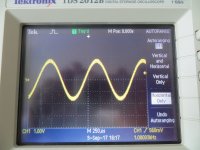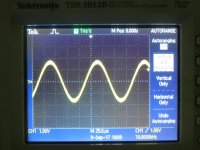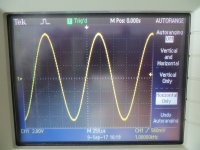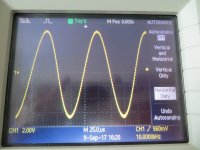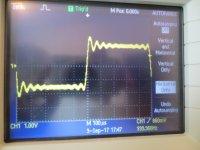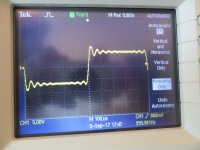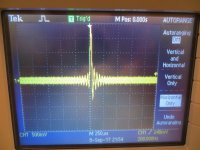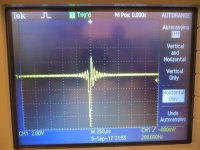As far as I know, DAM's have made their way to great DAC's. However, I haven't found any clue that Pi had made its way to great streamer or digital transport. I know some have made a music streamer out of a Pi but if I remember it was not hifi (was fun for sure). I doubt that it has the potential -- it has too many ports and doesn't seem to accept clean (separated and dedicated when necessary) power supply etc.
I have to admit that it is not easy to develop great music playing software though, but maybe there is a way to install a paid HDplayer/Jriver etc. into the single board computers.
I have to admit that it is not easy to develop great music playing software though, but maybe there is a way to install a paid HDplayer/Jriver etc. into the single board computers.
As a music server the Rpi does a good job. It's not going to affect the sound all that much, although there is the USB and Ethernet on the same chip issue. But, a lot of people use on-board i2s dacs and that bypasses the issue nicely.
There are several music server apps for the rpi.
They try to be bit perfect. People don't seem to believe that.
There are several music server apps for the rpi.
They try to be bit perfect. People don't seem to believe that.
As a music server the Rpi does a good job. It's not going to affect the sound all that much, although there is the USB and Ethernet on the same chip issue. But, a lot of people use on-board i2s dacs and that bypasses the issue nicely.
There are several music server apps for the rpi.
They try to be bit perfect. People don't seem to believe that.
Thanks for the information. I will dig deeper. Cheers.
For music server apps check out Rune and Volumio. Volumio has on-board i2s DACs in their store. Some are less than $50.
I guess the point I'm trying to make is, creating another SoC is not necessary. There are plenty out there with several different levels of functionality and speed.
I guess the point I'm trying to make is, creating another SoC is not necessary. There are plenty out there with several different levels of functionality and speed.
I have looked, and keep looking, on different boards and processor. I have no plans to compete with the cheap ones, and they actually can be used as great music servers, especially with an isolated and reclocking dac module, like the dam1021 or dam1121....
The RPi specific module I have been working on is just optimized for the RPi, don't have better sound but will be a good match mechanically and features wise.... And I have no intend to touch the software, way too much work....
If I did something, it would more be to add network audio streaming to my DACs, like Ravenna, Dante, AES67 and AVB, that would be a nice building block to have.... It's feasible to add a streaming core to the FPGA I already have on all boards, would require a little larger FPGA and some serious firmware work....
The RPi specific module I have been working on is just optimized for the RPi, don't have better sound but will be a good match mechanically and features wise.... And I have no intend to touch the software, way too much work....
If I did something, it would more be to add network audio streaming to my DACs, like Ravenna, Dante, AES67 and AVB, that would be a nice building block to have.... It's feasible to add a streaming core to the FPGA I already have on all boards, would require a little larger FPGA and some serious firmware work....
If I did something, it would more be to add network audio streaming to my DACs
Would that be DLNA compatible? It could be "a way" (somehow) to skip the need of RPi at all.
If I did something, it would more be to add network audio streaming to my DACs, like Ravenna, Dante, AES67 and AVB, that would be a nice building block to have.... It's feasible to add a streaming core to the FPGA I already have on all boards, would require a little larger FPGA and some serious firmware work....
I would love to see a multichannel Ravenna DAM that I could use for Stereo with separated Subwoofers and HomeCinema as well.
If I did something, it would more be to add network audio streaming to my DACs, like Ravenna, Dante, AES67 and AVB, that would be a nice building block to have.... It's feasible to add a streaming core to the FPGA I already have on all boards, would require a little larger FPGA and some serious firmware work....
Would be a very nice feat!
Although I must admit that I have moved from playing files to streaming...
I have looked, and keep looking, on different boards and processor. I have no plans to compete with the cheap ones, and they actually can be used as great music servers, especially with an isolated and reclocking dac module, like the dam1021 or dam1121....
The RPi specific module I have been working on is just optimized for the RPi, don't have better sound but will be a good match mechanically and features wise.... And I have no intend to touch the software, way too much work....
If I did something, it would more be to add network audio streaming to my DACs, like Ravenna, Dante, AES67 and AVB, that would be a nice building block to have.... It's feasible to add a streaming core to the FPGA I already have on all boards, would require a little larger FPGA and some serious firmware work....
Hi,
Usually, I do not step in, however, this early disclosure of market & tech strategy allows for some input.
Obviously, this forum is consumer-oriented due to inherent DIY cost-benefit approach. The "DIY line dam1021" is targeting this segment.
Now, the AES67 open standard for audio over IP as an ISO layer 3 protocol suite. Higher level protocols of the ISO stack implemented products (such as Ravenna, Dante...) however are targeting various pro segments.
For consumer market, the open standard approach is pushed by dlna.org, while the big ones push proprietary standards (Airplay, Chromecast...) in order to extract licence fees.
Thus, as a consumer, I find it important that vendors like Soekris keep a consistent strategy to supporti open standards (dlna).
The suggestion for "A nice building block" for IP based audio streaming can thus be implemented as a classified (dlna) DMP Digital Media Renderer.
Such a block enable value protection of installed base in all target segments:
o Standalone board with I2S output for the DIY community,
o innovative autonomous products just as the Audiophile line USB DACs.
o OEM module for design-in vendors (like engineered.ch NMR media renderer interface)
Best regards
Lars
#1042
bmxmen is online now bmxmen
diyAudio Member
Join Date: Apr 2012
Hi I have over 2years soekris v2 with mods 16x 470uf caps, 4BC 550/560 transistors and added 4 caps near bc transitor.All polymer caps. I have read that better is larger capacivience. It is god idea to change my mam 470uf to 1200uf polymers? Or even more? Thank You.
bmxmen is online now bmxmen
diyAudio Member
Join Date: Apr 2012
Hi I have over 2years soekris v2 with mods 16x 470uf caps, 4BC 550/560 transistors and added 4 caps near bc transitor.All polymer caps. I have read that better is larger capacivience. It is god idea to change my mam 470uf to 1200uf polymers? Or even more? Thank You.
Encouraged by the BC550/560 mod I tried two additional mods to my DAM1021.
First is removal of the output filter capacitors C135 & C142. I read that some found these output cap to degrade the sound. Surprisingly I found it to be the other way around - without the output cap the sound is in fact worst - it lost some clarity but at the same time sounded a bit rough. Luckily I didn't destroyed the caps when removing them so I promptly soldered them back in place.
While the caps were desoldered from the PCB I measured them to be 1.5nF so perhaps the adventurous can cap-roll it.
Second is adding additional capacitor to the 3.3V rail near the clock chip. I have an Audio Note Keiser 16V 4700uF cap on hand so I just used that. This mod appeared to open up the highs further with improved clarity and separation. There might be some low treble emphasis though. I'll let it run-in a bit (the cap is new) and also listen longer term before making a judgement but so far it is promising.
Anyone tried replacing the 3.3V regulator? I was planning to replace it with a newClassD regulator but decided to try adding a cap first. I don't want to use batteries as keeping them charged is too much trouble for me.
P.S. The Soekris DAM1021 is implemented inside a highly-modified Lampizator L7 DAC, powered by newClassD DC regulators at +10V/-10V. The raw outputs feed a 2A3 triode output stage.
First is removal of the output filter capacitors C135 & C142. I read that some found these output cap to degrade the sound. Surprisingly I found it to be the other way around - without the output cap the sound is in fact worst - it lost some clarity but at the same time sounded a bit rough. Luckily I didn't destroyed the caps when removing them so I promptly soldered them back in place.
While the caps were desoldered from the PCB I measured them to be 1.5nF so perhaps the adventurous can cap-roll it.
Second is adding additional capacitor to the 3.3V rail near the clock chip. I have an Audio Note Keiser 16V 4700uF cap on hand so I just used that. This mod appeared to open up the highs further with improved clarity and separation. There might be some low treble emphasis though. I'll let it run-in a bit (the cap is new) and also listen longer term before making a judgement but so far it is promising.
Anyone tried replacing the 3.3V regulator? I was planning to replace it with a newClassD regulator but decided to try adding a cap first. I don't want to use batteries as keeping them charged is too much trouble for me.
P.S. The Soekris DAM1021 is implemented inside a highly-modified Lampizator L7 DAC, powered by newClassD DC regulators at +10V/-10V. The raw outputs feed a 2A3 triode output stage.
Sound from original to mooded is small but not huge improvement...
I don+t speak about sound now i just want to set dac to default filter...if this is default than i am done with that dac. I want to use it with RPI.
It is connected to regulated supply not direct...and i use Input board from DIY gruopbuy.
Dimdim can you do some measurement on your dac? 1khz and 10khz -10db sine wave as i did.
Thank you.
While modding my DAC I did some scope checking using both the RAW output and the output after the 2A3 triode output stage.
The followings are some sine wave outputs (1V scale is RAW and 2V scale is tube output):
Note that the waveform after the tube output stage is 'thinner', suggesting some HF noises have been filtered out.
Attachments
Last edited:
Encouraged by the BC550/560 mod I tried two additional mods to my DAM1021.
First is removal of the output filter capacitors C135 & C142. I read that some found these output cap to degrade the sound. Surprisingly I found it to be the other way around - without the output cap the sound is in fact worst - it lost some clarity but at the same time sounded a bit rough. Luckily I didn't destroyed the caps when removing them so I promptly soldered them back in place.
While the caps were desoldered from the PCB I measured them to be 1.5nF so perhaps the adventurous can cap-roll it.
Second is adding additional capacitor to the 3.3V rail near the clock chip. I have an Audio Note Keiser 16V 4700uF cap on hand so I just used that. This mod appeared to open up the highs further with improved clarity and separation. There might be some low treble emphasis though. I'll let it run-in a bit (the cap is new) and also listen longer term before making a judgement but so far it is promising.
Anyone tried replacing the 3.3V regulator? I was planning to replace it with a newClassD regulator but decided to try adding a cap first. I don't want to use batteries as keeping them charged is too much trouble for me.
P.S. The Soekris DAM1021 is implemented inside a highly-modified Lampizator L7 DAC, powered by newClassD DC regulators at +10V/-10V. The raw outputs feed a 2A3 triode output stage.
I'm using 3.3V sparko discretes on my dams and I swore I could tell a difference for the better, however you never know with the endless subjectiveness when it comes to audio, with what those regulators cost you *want* it to sound better. I would recommend the mod, I also have 1400uf near the clock as well as an added 10uf ceramic.
I think the value of c135 is stated by Sören but I dont recall it beeing so small....
Encouraged by the BC550/560 mod I tried two additional mods to my DAM1021.
First is removal of the output filter capacitors C135 & C142. I read that some found these output cap to degrade the sound. Surprisingly I found it to be the other way around - without the output cap the sound is in fact worst - it lost some clarity but at the same time sounded a bit rough. Luckily I didn't destroyed the caps when removing them so I promptly soldered them back in place.
While the caps were desoldered from the PCB I measured them to be 1.5nF so perhaps the adventurous can cap-roll it.
Second is adding additional capacitor to the 3.3V rail near the clock chip. I have an Audio Note Keiser 16V 4700uF cap on hand so I just used that. This mod appeared to open up the highs further with improved clarity and separation. There might be some low treble emphasis though. I'll let it run-in a bit (the cap is new) and also listen longer term before making a judgement but so far it is promising.
Anyone tried replacing the 3.3V regulator? I was planning to replace it with a newClassD regulator but decided to try adding a cap first. I don't want to use batteries as keeping them charged is too much trouble for me.
P.S. The Soekris DAM1021 is implemented inside a highly-modified Lampizator L7 DAC, powered by newClassD DC regulators at +10V/-10V. The raw outputs feed a 2A3 triode output stage.
Soren-
No doubt you are busy but when you have a few minutes, could you answer one of the 3 or 4 pm's I have sent you over the past week asking when you will finish work/return on the 4 dam's I sent you 3 months ago? Thanks.
Thanks Soren for the reply.
- Home
- Vendor's Bazaar
- Reference DAC Module - Discrete R-2R Sign Magnitude 24 bit 384 KHz
